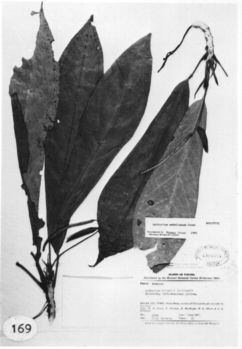




Anthurium wedelianum Croat, sp. nov.
Anthurium wedelianum ssp. wedelianum.
TYPE: Panama. Bocas del Toro: Punta Pena, vicinity of Chiriquícito, ca. 330 m, Lewis et al. 2150 (MO 1902384, holotype; GH, isotype).
Planta epiphytica; cataphyllum modice membranaceum persistens in fibris pallidis tenuibus; petiolus subteres, sulcatus, 4-9 cm longus; lamina modice membranacea, oblanceolata, basi acuta aut obtusa, 27-30 cm longa, 7-7.5 cm lata; inflorescentia foliis breviora; pedunculus teres, 7-9 cm longus; spatha oblongo-lanceolata, 3.5-5 cm longa; spadix stipite 1.3-1.5 cm longo, luteus, 8-8.5 cm longus; baccae ovoideo-ellipsoideae, 5.5-6 mm longae.
Epiphyte; stems less than 10 cm long, 0.5-1 cm diam.; the internodes short; roots few to moderately numerous m the lower portion of the stem; cataphylls moderately thin, 4-5 cm long, narrowly acuminate at the apex, weathering to thin, pale fibers that persist at the upper nodes.
LEAVES spreading; petioles subterete, sulcate adaxially, 4-9 cm long, one-third to one-sixth as long as blade; blades moderately thin, oblanceolate, narrowly acuminate at apex, acute to obtuse at base, 27-30 cm long, 7-7.5 cm wide, broadest well above the middle; drying yellowish green, both surfaces semiglossy; midrib weakly raised above, prominently raised below; primary lateral veins 7-9 per side, departing the midrib at 35-40° angle, straight or weakly curved to the collective vein, scarcely or not at all raised above, prominulous below; interprimary veins present, usually much less conspicuous than the primary laterals; tertiary veins prominulous; collective vein arising from the base or near the base; basal-most lateral vein usually joining the margin very near the base.
INFLORESCENCE much shorter than the leaves; peduncle terete, 7-9 cm long, shorter to longer than the petioles; spathe oblong-lanceolate, 3.5-5 cm long, acuminate at apex, narrowly acute at the base; inserted at a 25° angle on peduncle; stipe 1.3-1.5 cm long, 1-2 mm diam. (dry); spadix green to yellow, scarcely tapered to apex, 8-8.5 cm long, ca. 4 mm diam. at base, 3 mm diam. at apex; flowers rhombic, 3.2-3.8 mm long, 2.8-3 mm wide, the sides sigmoid, 2-3 flowers visible in the principal spiral; tepals semiglossy with conspicuous laphide cells visible, lateral tepals 2-2.2 mm wide, the inner margin thin, broadly rounded to obtusely angular; pistils not emeargent tout tepals turned up wea^Vy on drying; stamens not studied.
INFRUCTESCENCE to ca. 17 cm long, 1.3 cm diam.; berries ovoid-ellipsoid, 5.5-6 mm long, 4.5-5 mm diam., rounded on both ends; mesocarp with numerous, short raphide cells; seeds 2, about as broad as long, much flattened with a gelatinous appendage at one end. Fig. 169.
Anthurium wedelianum ssp. wedelianum is endemic to Panama and is known only from Bocas del Toro Province at sea level to approximately 300 m in a premontane wet forest life zone.
The species, tentatively placed in section Urospadix, is distinguished by its thin, oblong-ob-lanceolate, epunctate, green-drying leaf blades with prominent collective veins arising from the base. Also characteristic are its persistent, slender, pale cataphyll fibers and its slender green to yellow, prominently stipitate spadix.
The species is closest to Anthurium platyrhizum, which differs in having flattened, ribbon-like (versus terete) roots and a shorter, thicker, scarcely tapered spadix with the flowers prominently raised and separated from one another by sunken lines. Subspecies wedelianum is distinguished from ssp. viridispadix by its lower ele-vational range (to 300 m versus 500 to 800 m), its different life zone (premontane wet versus tropical wet and premontane rain forest), and by its yellow spadix with distinct linear raphide cells visible in the tepals. Subspecies viridispadix differs in having a dark green spadix and flowers that show no evidence of linear raphide cells.
Specimens now called Anthurium wedelianum were once called A. michelii and look superfi-cially like the type of that species. The type of A, michelii is an aberrant, unusually small specimen for the species (see discussion following A. michelii).
It is named in honor of its first collector, H. von Wedel, who collected actively in Bocas del Toro province in the late 1940s.

Map of Mesoamerican specimens with coordinates
Panama Bocas del Toro: 300 m, 8.55N 82.10W, 28 May 1988, Gordon McPherson
12571 (MO).
Panama Bocas del Toro: 550 m, 8.50N 82.15W, 4 March 1986, Gordon McPherson
8544 (MO).
Panama Bocas del Toro: 300 m, 8.52N 82.10W, 24 Apr 1988, Thompson 4933
(CM).
Panama Bocas del Toro:, , Lewis et al. 2150 (GH).